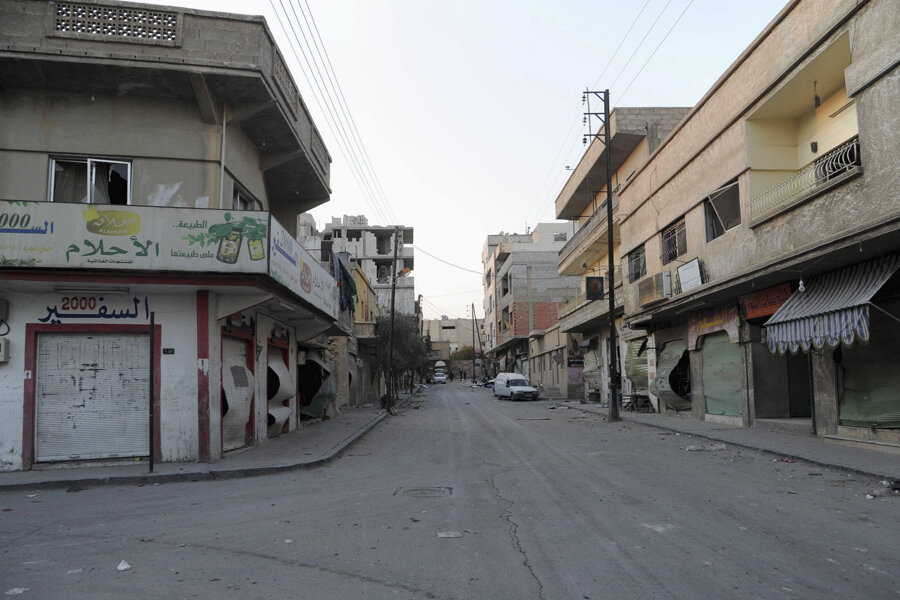Syrian Army goes all-in to take back strategic highway
Loading...
| Beirut, Lebanon
An offensive by the regime of Syrian President Bashar al-Assad to restore full control of the Qalamoun area north of Damascus is fully under way, with fierce fighting and shelling reported for the past two weeks at the northern end of the strategically located territory.
The Syrian Army and its Shiite paramilitary allies from Iraq and Lebanon’s Hezbollah appear to be punching southward, attempting to seize towns that straddle the main highway connecting Damascus to Homs, Syria’s third-largest city. The rebel presence in the mountainous Qalamoun area threatens regime access to the highway, which links the two cities and the Mediterranean coast. It also serves as a support hub for rebel forces dug in around eastern and southern Damascus, where fierce battles have raged recently.
Last week, regime forces reportedly seized Qarah and Deir Attiyah at the northern end of Qalamoun before moving on to pound Nabk, the next town along the highway, with artillery and air strikes.
“Assad forces are fiercely shelling the city of Nabk with all kinds of weaponry as they resume clashes with the Free Syrian Army on the Damascus-Homs highway near the city and other axes in the mountainous area,” said a statement released Monday by the Qalamoun Media Center run by opposition activists. The Center claimed that 24 people were killed in Qalamoun on Sunday, 14 of them in Nabk during artillery shelling and air strikes.
Rebel forces increased their presence in Qalamoun, adjacent to Lebanon’s eastern border, during the summer and overran some military bases there in anticipation of an eventual regime attack. The area has a sizable Christian population, much of which views with misgivings the rebel forces that have taken over their towns and villages, especially factions such as Al Qaeda affiliates Jabhat al-Nusra and the Islamic State of Iraq and the Levant (ISIS).
Prior to the onset of the Qalamoun offensive, the predominantly Christian town of Deir Attiyah was in the Syrian Army's hands, while Nabk, four miles to the south, was under rebel control. A tacit agreement between the two enemies saw rebels promising not to attack Syrian troops on the highway in exchange for calm in Nabk. The understanding held until after the Qalamoun offensive commenced on Nov. 15 with a Syrian Army assault against Qarah. On Nov. 20, rebels mounted as many as four suicide bomb attacks against regime positions near Deir Attiyah before capturing much of the town two days later. The Syrian Army counter-attacked on Nov. 23 and retook Deir Attiyah before concentrating its efforts on Nabk.
Most of the residents of Qarah, Nabk, Deir Attiyah, and Yabroud have fled the fighting, crossing the nearby border with Lebanon. An estimated 20,000 refugees have arrived in Lebanon since the Qalamoun offensive began, most of them in the first few days, according to Dana Sleiman, Lebanon spokesperson for the United Nations High Commission for Refugees.
Most of the fresh influx of refugees have settled in Arsal, a Sunni border town in the eastern Bekaa Valley that is a bastion of support for Syrian rebel groups. Arsal has seen its population of some 38,000 residents nearly triple since the conflict in Syria began due to the flow of refugees.
Several Army bases in the area
The Syrian Army operates several bases across the Qalamoun area, which brings almost all the area within range of artillery guns. Its strategy in Qalamoun appears to be to besiege each town one after the other using artillery and air power to crush the rebels and drive them out. In the next few weeks, the winter snows will arrive, covering the mountain tops and cutting the cross-border tracks linking Qalamoun to Arsal in Lebanon. Rebel groups driven from the relative comfort of Qalamoun’s towns into the rugged snow-swept mountains could become more vulnerable to attack by artillery and aircraft.
Hezbollah fighters who are battling alongside the Syrian Army have carved up the Qalamoun area into sectors and intend to play a lead role in locating and attacking bands of rebels hiding out in the mountains or directing artillery or air strikes against them, says a Hezbollah member in a recent conversation. The fighter, who spoke on condition of anonymity, says that the campaign would more closely resemble a counterinsurgency campaign lasting several months than a conventional military offensive with an emphasis on “reconnaissance, air power, artillery, and special forces.”
Higher casualties than reported?
Still, Hezbollah has suffered casualties since the Qalamoun attack began. Last week, Ali Hajj Hassan, the nephew of a Hezbollah member of the Lebanese parliament, was killed along with three other party members in Qalamoun. Another fighter, nicknamed “Sayyed Nasrallah” after Hezbollah’s leader Sheikh Hassan Nasrallah, also was killed in Qalamoun last week.
Sources close to Hezbollah say that fighting in northern Qalamoun last week resulted in more casualties than has been publicly announced. At least 23 Hezbollah men have been privately confirmed killed by the party and the figure could be as high as 40. The circumstances of their deaths are unclear, but the sources say that the Hezbollah men were abandoned on the battlefield when Syrian Army troops fled, then surrounded by rebel forces and cut down.
The account cannot be immediately confirmed, but it aligns with reports that some Hezbollah cadres distrust their Syrian Army allies, whom they privately accuse of accepting bribes from rebels and lacking battlefield discipline. The dead fighters' bodies are still in Syria, the sources say. Another squad of five Hezbollah fighters who lost contact with their command post in Qalamoun and were feared dead turned up alive after fighting their way through rebel lines, the sources say.







